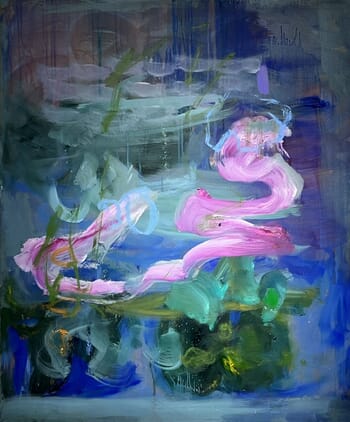Explore our selection of abstract expressionist art for sale online. Showcasing work by some of the best contemporary abstract expressionists active today, our collection is ever evolving to ensure that it always contains the latest inspiring works for art enthusiasts around the world. We collect works from a diverse range of artists, so if you are not sure where to start, have a look at our abstract expressionist photography, paintings and prints.
HISTORY OF ABSTRACT EXPRESSIONISM
Abstract Expressionism is generally categorised into two distinctive styles: action painting and colour field painting. Most works are characterised by gestural brush strokes and often monumental scale. The style gives an impression of spontaneity and abstraction, yet it can be both expressive and emotional in its effect on the viewer.
Abstract Expressionism was born out of post-second world war anxiety and trauma that stripped Paris of its mantle as capital of the art world and saw New York steal its crown. This led to America’s art boom and dominance of the international art world. With its pieces intended not as objects of passive consumption, but as two-way encounters between artist and viewers, the movement redefined painting and saw artists break away from accepted conventions. It finds its roots in the surrealist notion that art should come from the unconscious and is inspired by the automatism of Joan Miró, whose work is reflected in Jackson Pollock's infamous drip paintings.
The movement was developed in the 1940s and 1950s by American painters such as Jackson Pollock, Mark Rothko and William de Kooning. It was mostly based in New York City and became known as the New York School. Though the shock of its initial newness had subsided by the 1960s, it's methods and proponents remained highly influential in the art world, paving the way for movements such as Tachisme, Lyrical Abstraction, Pop Art, Minimalism and Neo-expressionism. Artists such as Jules Olitski and Joan Mitchell went on to maintain the movement, working in the style for many years and extending and expanding both its visual and philosophical implications.
The action painting style of Abstract Expressionism was led by Pollock and de Kooning, who would work in a spontaneous, improvisatory manner, attacking their canvases with expressive brush strokes, often using large brushes in order to leave sweeping, gestural marks – sometimes even dancing upon the canvas and letting the paint drip upon it, falling according to chance. This expression of the subconscious psyche was a pivotal element of the action painting style, which sought to express the creative unconscious.
Meanwhile, the colour field style was pioneered by artists such as Mark Rothko, Barnett Newman and Clyfford Still, who filled their canvases with large areas of a single colour. These artists were deeply interested in religion and mythology and created works with the intention of eliciting a contemplative or meditational response in the viewer.
Pollock’s drip paintings are undoubtedly the most well-known of the action painting genre, with his complexly entangled skeins of paint entwining into suggestive and striking linear patterns creating a visually unmistakable effect. Meanwhile, the most outstanding colour field painter was Mark Rothko, whose work consisted of shimmering, resonating, soft-edged rectangles in solid colours.
ABSTRACT EXPRESSIONIST ART FROM LEADING ARTISTS
Award-winning, German-born Abstract Expressionist artist Daniela Schweinsberg, whose explosively colourful, deeply textured pieces are sure to stand out against any backdrop.
Have a look at the pieces created by Hertfordshire-based artist Paresh Nrshinga, whose spiritual influence and flirtation with the Abstract Expressionist genre, results in a strikingly bright and captivating collection of pieces. This young artist, whose fluid style takes inspiration from music, boasts an impressive client base, including the Queen of Abu Dhabi.
Another artist whose Abstract Expressionist style should not be missed is Bea Garding Schubert, whose fascinating pieces seem to reveal more and more the longer you look at them. Her works inspire hope and happiness, and her distinctive colour palette adds a refreshing burst of pastel-toned joy to any room.
Prefer something more dark and brooding? Look no further than the work of painter and musician Francesco D'Adamo, whose thought-provoking pieces are created using a mixture of different techniques, producing a staggeringly concrete image.
Frank Stella became the artist he is in New York. He was a pioneer of minimalism and became well-known for Op Art. Abstract expressionism, especially the works of Pollock and Kline, served as his inspiration. Frank Stella also explored many techniques and colour palettes, which makes him a versatile artist that many can enjoy!
Matthew Dibble’s abstract paintings channel the raw energy of the Abstract Expressionist movement, drawing inspiration from the spontaneous dynamism of Pollock and the bold structures of de Kooning. His works, like Apprehension (2024), merge emotional candour with gestural brushstrokes, creating layered compositions. Dibble’s art captures the chaos and harmony of modern life, offering a deeply evocative visual experience.
Finally, for a unique take on nature, take a glance at the dazzling works of Chinese artist Jinsheng You. His remarkable pieces express not only a love of colour but a heartfelt connection between artist and subject and are sure to add a welcome pop of energy to any art lover’s collection.
Find out more in our Guide To Abstract Art.




















































